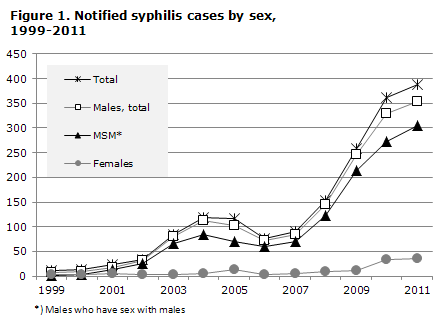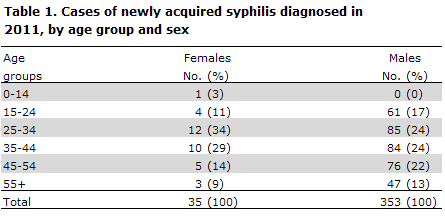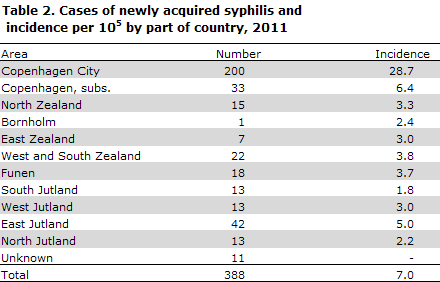No 37 - 2012
Syphilis 2011
Syphilis 2011
Newly acquired syphilis, i.e. primary and secondary syphilis, is notified to the Department of Infectious Disease Epidemiology, Statens Serum Institut (SSI) on Form 1510.2011 saw 434 notifications of newly acquired syphilis in a total of 430 persons. A total of 395 (91%) were male and 39 (9%) were female cases. The median age for females was 34 years (range: 1-68 years), and for males 38 years (range 15-82 years). A total of 388 (89%) of the cases were notified to the Notification System for Infectious Diseases (NSID), Department of Infectious Disease Epidemiology (DIDE).
In 330 (76%) of the 434 cases, a sample had been submitted to the Department of Microbiological Diagnostics and Virology (DMDV), SSI and the case had also been notified with the NSID, DIDE. In 58 of the cases, a sample had been submitted to the DMDV, and in 46 (11%) cases infection had only been notified to the NSID.
Thus, the number of notified syphilis cases has increased further since 2010, Figure 1.

Syphilis diagnostics
Among the 376 cases in which samples were submitted to the DMDV, 306 (81%) were detected by serology, 58 (16%) by serology as well as PCR, while 12 (3%) cases were detected by PCR exclusively.Congenital syphilis
A single case of congenital syphilis was notified. The parents of the child, born in the beginning of 2010, were of non-Danish origin. The mother had not been screened for syphilis as part of the general pregnancy screening, which only came into force as from January 2010. The child was diagnosed with congenital syphilis in May 2011 upon suspicion raised due to its development.Demography of the notified cases
The 388 notified cases included 353 (95%) male and 35 female cases. The median age was 38 years for males (range: 15-79 years) and 34 years for females (range 1-68 years), Table 1.
The majority of the notified cases were Danish-born: 322 (83%), while 50 (13%) were immigrants, nine (2%) second-generation immigrants; furthermore, four (1%) were tourists and three (1%) were of unknown origin. Among the male cases, 304 (86%) occurred in males who have sex with males (MSM).
Table 2 shows the distribution by part of country. As in previous years, many cases (52%) were observed in Copenhagen City.

Transmission
Country of infection was stated in 348 (88%) cases. Among males, a total of 281 (80%) were infected in Denmark, and among females the corresponding number was 22 (63%). Among heterosexually infected males, 23 (61%) were infected in Denmark, while this was the case for 256 (91%) of MSMs.Syphilis and HIV
Information on HIV status was avaliable for 328 males (95% of MSMs and 84% of heterosexually infected males), and for 31 (89%) females.Among HIV-tested males, 113 (34%) were HIV positives. Among MSMs, 109 (38%) were HIV positives, and among heterosexually infected males three (8%) were HIV positives. For the last HIV positive male, the mode of infection was unknown. None of the females were known HIV positives.
Commentary
2010 saw the first case since 2003 of congenital syphilis in Denmark, and in 2011 another child was notified. The mother of the child had not formed part of the general screening introduced in the beginning of 2010.
Congenital syphilis may cause serious late sequelae. As the disease does not always present at birth, it is particularly important to be aware of the diagnosis when the mother has not been screened as part of the general screening. Late-stage congenital syphilis may manifest as damage to the central nervous system, hearing, bones and teeth.
Even though syphilis is seen among heterosexuals, the disease continues to be more widespread among MSM, and the increase in this group continued in 2011, in line with the trends observed in other European countries, e.g. Germany, www.eurosurveillance. Nevertheless, the first semester of 2012 has seen considerably fewer notifications than were recorded at the same point in time during the previous year. It is not known at present whether this is owed to a real decrease in the number of cases or to a decrease in notifications and/or diagnostic activity.
In 2011, the general screening of pregnant women has yielded six female syphilis notifications, EPI-NEWS 14-15/12. This number is in line with 2010, when seven cases were notified.
Syphilis is a marker of unprotected sex and therefore also a marker for risk of HIV infection and of infection with other sexually transmitted diseases. It is still essential that MSMs who are tested for syphilis also undergo HIV testing, EPI-NEWS 46/09. Furthermore, they should be tested for lymphogranuloma venereum (LGV), hepatitis B and C and gonorrhoea.
Correct diagnosis and staging are important for the treatment of the individual syphilis patient as well as for the monitoring efforts. This means that tentative diagnoses based on positive screening results should be verified trough extended serological tests. PCR testing is expedient for detection of Treponema pallidum in chancre material and is often positive before any antibodies can be detected.
(B. Søborg, S. Cowan, Department of infectious Disease Epidemiology, S. Hoffmann, Microbiology and Infection Control)
Link to previous issues of EPI-NEWS
12 September 2012